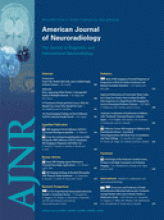Review ArticleReview Articles
Open Access
Smart MR Imaging Agents Relevant to Potential Neurologic Applications
C.S. Bonnet and É. Tóth
American Journal of Neuroradiology March 2010, 31 (3) 401-409; DOI: https://doi.org/10.3174/ajnr.A1753

References
- 1.↵
- Merbach AE,
- Toth E
- 2.↵
- Caravan P,
- Ellison JJ,
- McMurry TJ,
- et al
- 3.↵
- Allen MJ,
- Meade TJ
- 4.↵
- 5.↵
- Zhang S,
- Winter P,
- Wu K,
- et al
- 6.↵
- 7.↵
- Woessner DE,
- Zhang S,
- Merritt ME,
- et al
- 8.↵
- 9.↵
- 10.↵
- Jasanoff A
- 11.↵
- Que LE,
- Domaille DW,
- Chang CJ
- 12.↵
- Logothetis NK
- 13.↵
- Waters J,
- Larkum M,
- Sakmann B,
- et al
- 14.↵
- Kerr JND,
- Greenberg D,
- Helmchen F
- 15.↵
- Ohki K,
- Chung S,
- Ch'ng YH,
- et al
- 16.↵
- Somjen GG
- 17.↵
- 18.↵
- Panov AV,
- Burke JR,
- Strittmatter WJ,
- et al
- 19.↵
- Yan HD,
- Lim W,
- Lee KW,
- et al
- 20.↵
- Jimerson DC,
- Post RM,
- Carman JS,
- et al
- 21.↵
- Yarlagadda A
- 22.↵
- Gailly P
- 23.↵
- Lin YJ,
- Koretsky AP
- 24.↵
- Koretsky AP,
- Silva AC
- 25.↵
- Atanasijevic T,
- Shusteff M,
- Fam P,
- et al
- 26.↵
- Shapiro MG,
- Atanasijevic T,
- Faas H,
- et al
- 27.↵
- Li W,
- Fraser SE,
- Meade TJ
- 28.↵
- 29.↵
- 30.↵
- 31.↵
- Dhingra K,
- Maier ME,
- Beyerlein M,
- et al
- 32.↵
- Faller P,
- Hureau C
- 33.↵
- Hanaoka K,
- Kikuchi K,
- Urano Y,
- et al
- 34.↵
- Hanaoka K,
- Kikuchi K,
- Urano Y,
- et al
- 35.↵
- 36.↵
- Major JL,
- Parigi G,
- Luchinat C,
- et al
- 37.↵
- 38.↵
- 39.↵
- 40.↵
- 41.↵
- 42.↵
- Parac-Vogt TN,
- Vander Elst L,
- Kimpe K,
- et al
- 43.↵
- Jacques V,
- Desreux JF
- 44.↵
- Aime S,
- Botta M,
- Fasano M,
- et al
- 45.↵
- Gaggelli E,
- Kozlowsky H,
- Valensin D,
- et al
- 46.↵
- Que EL,
- Chang CJ
- 47.↵
- Gillies RJ,
- Raghunand N,
- Karczmar GS,
- et al
- 48.↵
- Chesler M
- 49.↵
- 50.↵
- Aime S,
- Crich SG,
- Gianolio E,
- et al
- 51.↵
- Mikawa M,
- Miwa N,
- Brautigam M,
- et al
- 52.↵
- Aime S,
- Crich SG,
- Botta M,
- et al
- 53.↵
- Lowe MP,
- Parker D,
- Reany O,
- et al
- 54.↵
- Hovland R,
- Glogard C,
- Aasen AJ,
- et al
- 55.↵
- Toth E,
- Bolskar RD,
- Borel A,
- et al
- 56.↵
- 57.↵
- Raghunand N,
- Howison C,
- Sherry AD,
- et al
- 58.↵
- 59.↵
- 60.↵
- Ward KM,
- Balaban RS
- 61.↵
- Aime S,
- Barge A,
- Delli Castelli D,
- et al
- 62.↵
- 63.↵
- Moats RA,
- Fraser SE,
- Meade TJ
- 64.↵
- Louie AY,
- Hüber MM,
- Ahresn ET,
- et al
- 65.↵
- Anelli PL,
- Bertini I,
- Fragai M,
- et al
- 66.↵
- 67.↵
- Lauffer RB,
- McMurry TJ,
- Dunham SO,
- et al
- 68.↵
- Mazooz G,
- Mehlman T,
- Lai TS,
- et al
- 69.↵
- Shiftan L,
- Israely T,
- Cohen M,
- et al
- 70.↵
- Chen JW,
- Pham W,
- Weissleder R,
- et al
- 71.↵
- Querol M,
- Chen JW,
- Weissleder R,
- et al
- 72.↵
- 73.↵
- 74.↵
- 75.↵
- 76.↵
- Raghunand N,
- Gatenby RA,
- Gillies RJ
- 77.↵
- Rofstad EK
- 78.↵
- 79.↵
- Matsumoto H,
- Inoue N,
- Takaoka H,
- et al
- 80.↵
- 81.↵
- 82.↵
In this issue
Advertisement
C.S. Bonnet, É. Tóth
Smart MR Imaging Agents Relevant to Potential Neurologic Applications
American Journal of Neuroradiology Mar 2010, 31 (3) 401-409; DOI: 10.3174/ajnr.A1753
0 Responses
Jump to section
Related Articles
- No related articles found.
Cited By...
- No citing articles found.
This article has not yet been cited by articles in journals that are participating in Crossref Cited-by Linking.
More in this TOC Section
Similar Articles
Advertisement











